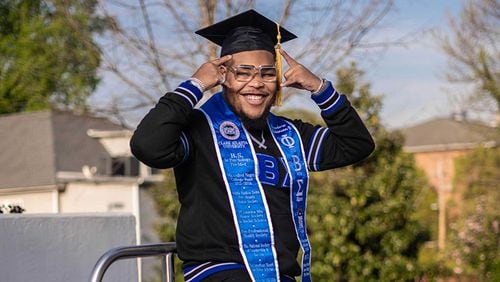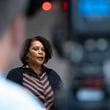The State Capitol was a little cozier than usual on Monday, its marble walls wrapped in home-made quilts made by Georgia artists.
On display were more than 50 quilts, in traditional pineapple and log cabin patterns, and in free-form landscapes and still-lifes. They were created by stitchers from Calhoun to Valdosta, to raise interest in establishing a regional nonprofit museum to showcase this art form.
The museum is planned to take up residence in a resuscitated cotton warehouse in Carrollton, and while Monday's quilters were happy that it would boost tourism and downtown traffic, they seemed more excited about the prospect of simply showing off their handiwork. No quilter wants to hide their efforts in a blanket chest.
"A quilt is something you've got to share," said Alice Smith of Centerville, whose Macon-based group was displaying a quilt embroidered with the names of Georgia Music Hall of Fame stars.
The sharing generally begins even before the first snip. While quilting can be solitary, many Georgia quilters belong to one of more than 70 guilds in the state, dozens of which were represented in Monday's exhibition. These groups become their sounding boards, their shoulders to cry on, their soul sisters.
The Cherokee Crazy Quilters (the name refers to the pattern, not to the mental stability of the members) brought a stand-out work of art to the show, a king-sized quilt, composed of 1,672 pieces of fabric, dominated by a mosaic rendering of the Old Stone Barn in Canton. The barn, now a community center, is the meeting place for the 50 women in the guild, and in this portrait, named Cherokee Tales, the barn is pieced together from fabric in golds, browns and reds. Surrounding it are poinsettias and Cherokee roses. Winding around the perimeter of the quilt is a tracery of blue triangles, a subtle representation of the Trail of Tears.
Every quilting pattern has a name, and the pattern of the border is called, fittingly, Road to Oklahoma.
"This quilt has been all over Cherokee County," on an informal tour to raise interest in creating the Southeastern Quilt and Textile Museum, said guild member Sally Joss.
Joss and others see such quilts as works of art that need a forum. The Georgia Quilt Council was created several years ago to piece together plans for the museum. The quilts made for Monday's exhibition will eventually be auctioned to raise funds to help renovate the warehouse.
Judging from the success of the National Quilting Museum in Paducah, Kentucky, there is a pent-up demand for such a facility. "In April 60,000 women descend on that town in one week," for the annual competition and festival of the American Quilter's Society, said Marilyn Osterkamp, president of the Southeastern museum's board. More than $122,000 in prizes are handed out that week in Paducah, including a $20,000 prize for best of show.
The Kentucky museum usually acquires the quilt that wins first prize, but Osterkamp said there is a story of one winning quilter who opted to keep her quilt rather than take the prize. She couldn't bear to part with it.
Pat Hitchcock of Valdosta, a member of the Withlacoochee Quilters Guild, would understand. “I hate to give them away, because I’m part of it.”
The calming power of quilting seems to extend to the user of the quilt as well. “Most quilts are very comforting,” said Ethel Bill of Warner Robins. “I have a friend whose husband died. I gave her a quilt and she just cuddled up in it.” Many of the women gathered Monday had made quilts for people in crisis – whether for servicemen back from combat duties or for children suffering from cancer.
Europe does not have the same history of quilting, said Teri Thomas, who grew up in Poland during the Third Reich and was taken to a labor camp when she was 14 years old. She survived, was liberated by Patton’s Third Army, and fell in love with America, moving here in 1946. (Along with her guild badge she wears a small American flag pin made of rhinestones.)
Today Thomas is part of the Scrappy Quilters of Calhoun, and she and Dorothy Sauder assembled a delicate quilt for Monday's show based on the Dresden Plate pattern called “Dresden Flower.”
“I wanted to learn this American art form,” said Thomas.
Donations for the museum can be sent to: Southeastern Quilt and Textile Museum at P.O. Box 1189, Carrollton, Ga. 30112.
About the Author






